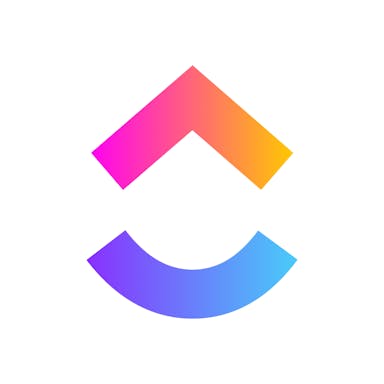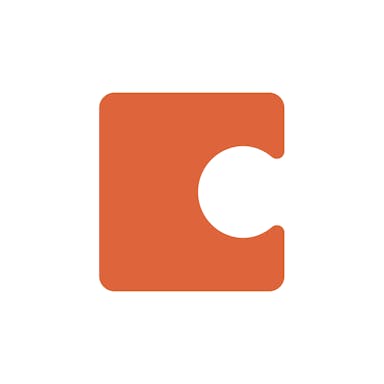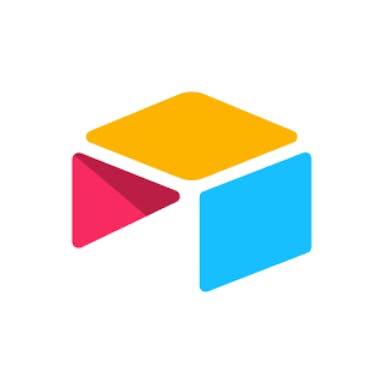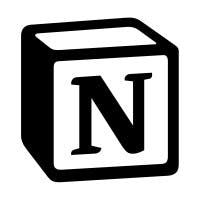Thesis
Organizations are increasingly managing a larger variety of apps. This presents challenges such as high costs, inefficient management, security concerns, and decreased productivity. App overload is transforming the digital workplace. Though apps such as Slack, Notion, Google Drive, and Dropbox can be beneficial, they can also cause disruption and decrease productivity. Organizations deployed an average of 89 apps in 2022, a 24% increase from 2016. For larger companies, this figure was even higher; companies with over 2K employees deployed an average of 187 apps.
With an increasing number of apps being used by organizations, there is an ever-present "toggling tax" associated with switching from one application to another, as well as challenges in managing and operating across what may feel like countless information silos. One study across Fortune 500 companies found that workers toggle between apps and websites 1.2K times daily, on average, totaling almost 4 hours a week. This is equivalent to 9% of time spent at work on average, highlighting the need for a more well-integrated work operating system that can reduce the “toggling tax” and thereby increase workplace productivity.
ClickUp is an all-in-one productivity platform that brings teams, tasks, and tools together in one place. ClickUp aims to offer a bundled productivity solution that streamlines workflows and increases collaboration by integrating various, often-standalone features across task management, messaging, documents, spreadsheets, goal-setting, and more.
Founding Story

Source: ClickUp
ClickUp was founded by Zeb Evans (CEO) and Alex Yurkowski (CTO) in 2017. Founder Zeb Evans had a longstanding entrepreneurial background. At a young age, Evans set up an account with the Oriental Trading Company, a direct-marketing retailer, to sell party supplies. He got into DJing in high school and started a mobile DJ company. After enrolling at Virginia Tech in 2008, he pursued music production and artist management. However, after a near-death experience in 2011 where he was robbed and had a gun pointed at his head, Evans decided to drop out of school and focus on his business. He eventually founded Fast Followerz, which sold social media automation tools for artists and influencers. By 2015, Fast Followerz had 25 employees, over 1K clients, and $2.5 million in annual revenue.
After another near-death experience in 2015 where he collapsed and nearly died, Evans started working on Mimri, a social media platform. He was joined by Chris Cunningham, a friend who had worked with him on Fast Followerz (who is now ClickUp’s Head of Influencer Marketing as of 2023) along with some others from the Fast Followerz team. He was also joined by IBM engineer Alex Yurkowski, who agreed to be cofounder and CTO. Together, the team moved to Silicon Valley.
The team used multiple productivity applications, including Asana, Trello, and Slack, but found that none were particularly helpful in accelerating their productivity. Yurkowski decided to build a custom, bundled app that better served their productivity needs, a solution that quickly became popular outside the company. After realizing that the productivity application had more potential than Mimri, ClickUp, as it was named, became the team’s focus. With no marketing budget for 3 years, ClickUp's early growth was primarily through word-of-mouth. By the spring of 2020, about three years after the company had been founded, ClickUp had 100K customers.
Product
ClickUp’s cloud-based project management platform is designed to help individuals and teams organize their work, collaborate, and achieve their goals. The company aspires to offer workplace productivity tools with functions across documentation, task management, collaboration, and more.
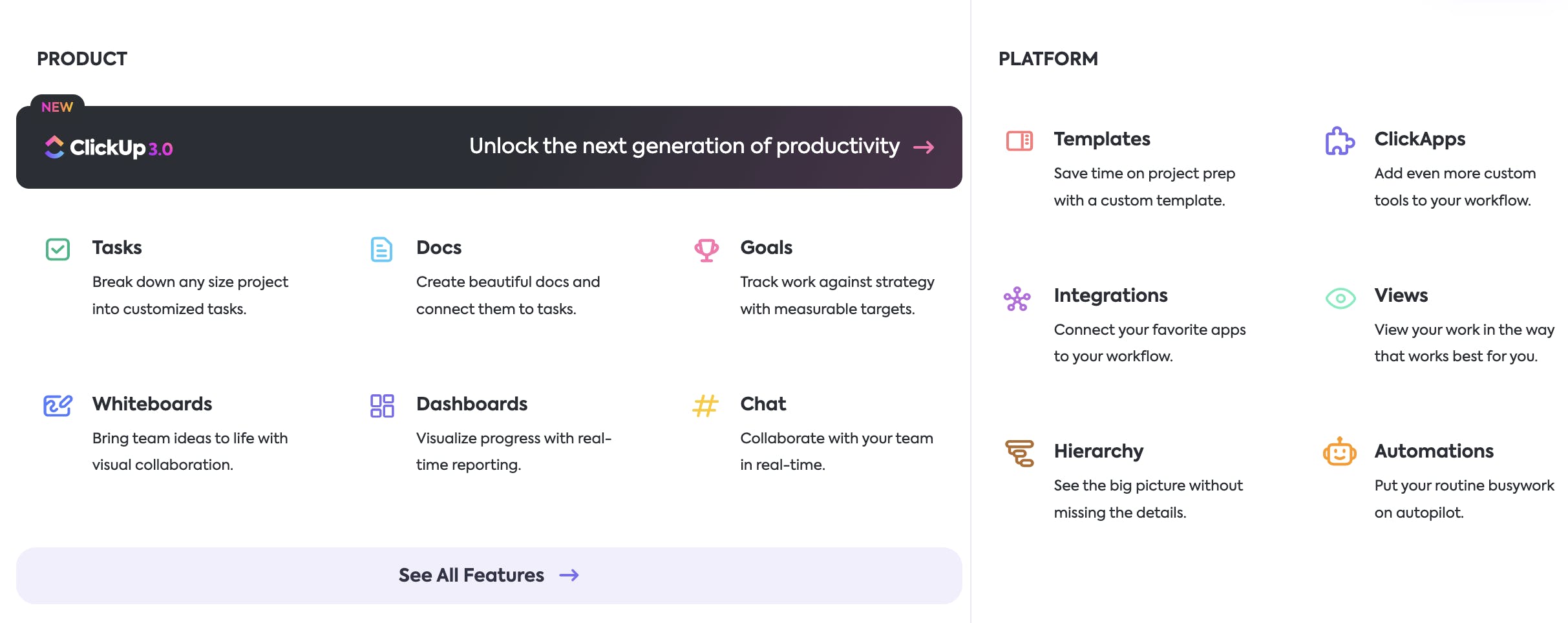
Source: ClickUp
Tasks
ClickUp's task management feature is versatile, allowing users to create and organize tasks in various formats, such as lists, boards, and calendars. Users can set due dates, assign tasks to team members, add comments and attachments, and track progress using visual aids like progress bars, checklists, and time tracking. ClickUp also offers templates and automation related to task management.
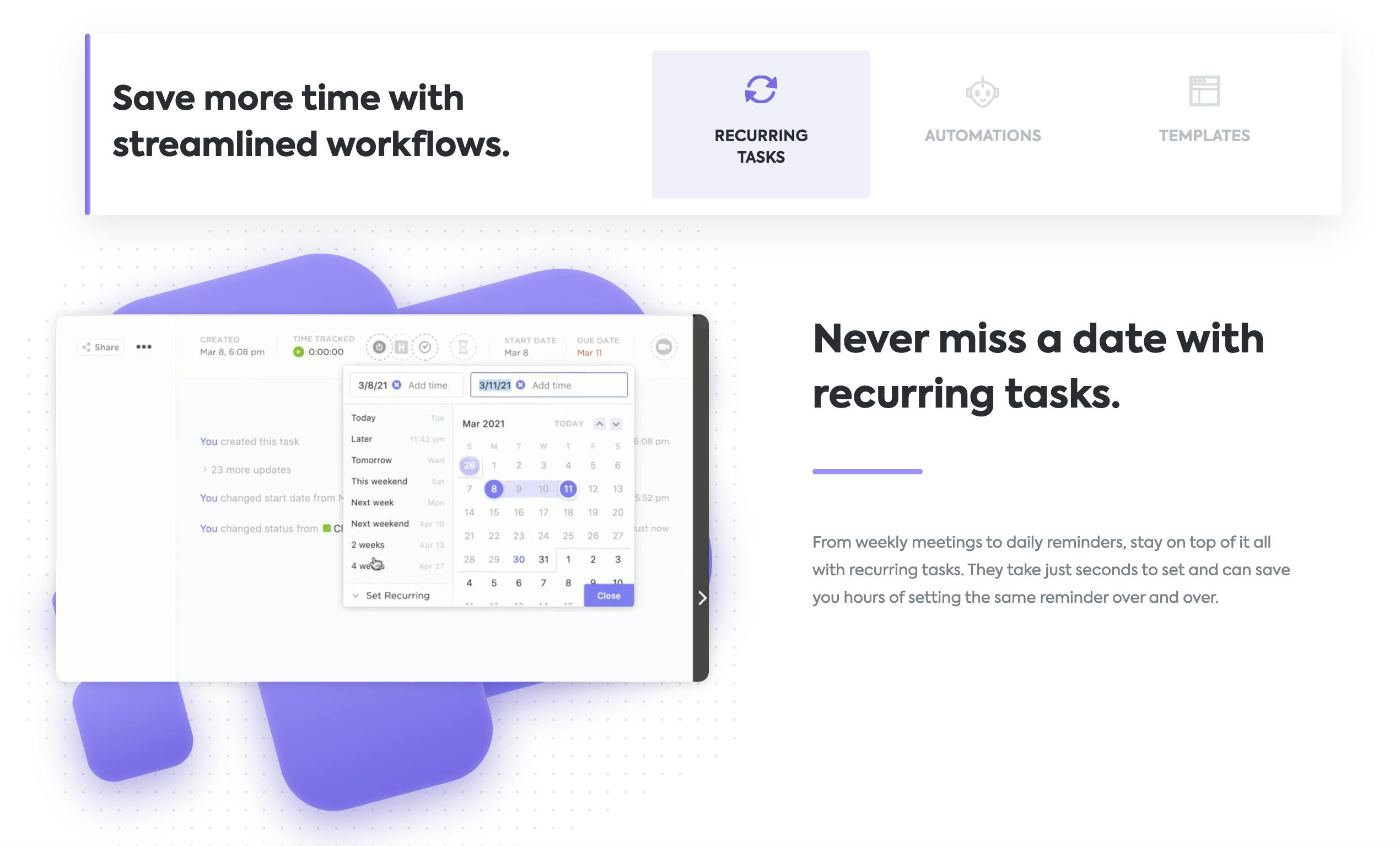
Source: ClickUp
Docs
ClickUp Docs is a tool for creating and organizing internal team documentation. This allows users to create and edit documents, wikis, and knowledge bases within ClickUp, which users can then organize using folders and tags. ClickUp’s text editor allows users to edit and format documents in real time with headings, bullet points, tables, nested pages, images, tags, comments, trackable action items and tasks, and custom visibility permissions. Additionally, users can collaborate on documents in real-time with team members and connect documents to workflows throughout ClickUp.
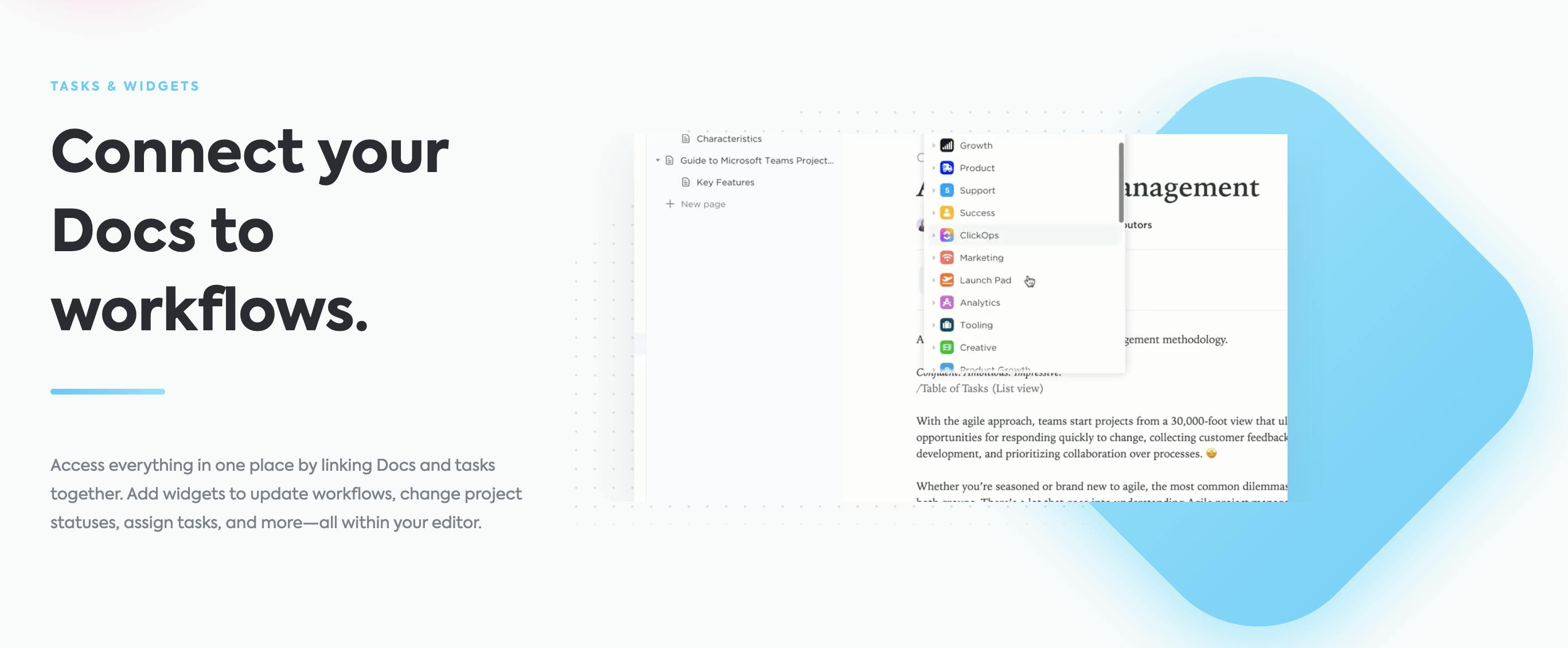
Source: ClickUp
Goals
ClickUp Goals is designed to help teams organize, prioritize, and complete their objectives. Users can create and track goals at the team and individual levels. Goals can be aligned with specific projects, initiatives, or metrics, making tracking progress and measuring success easier. Users can set due dates, assign owners, and add key results to their goals. Built-in progress bars can illustrate how close goals are to completion, and users can view progress reports and insights to make data-driven decisions.
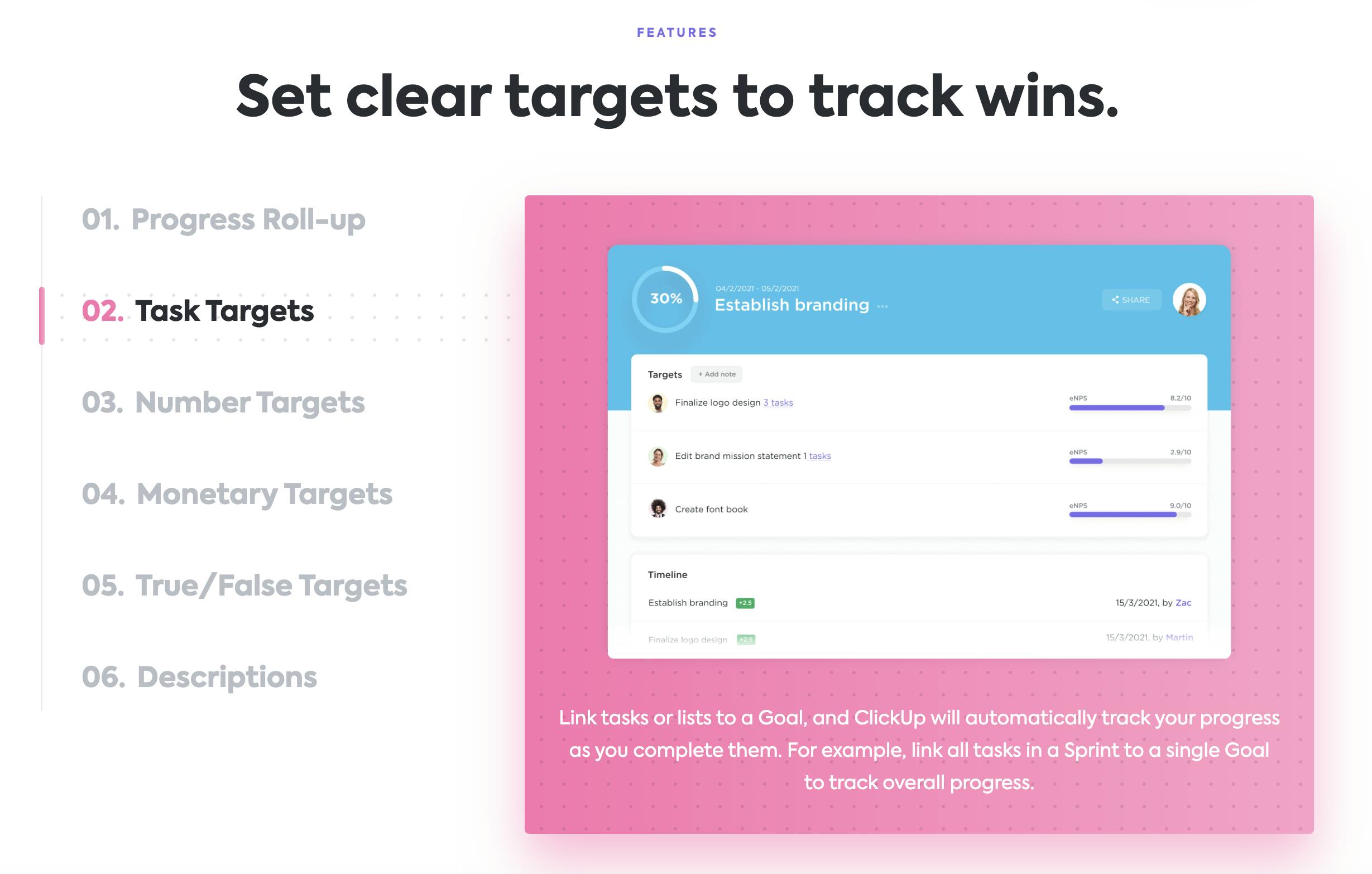
Source: ClickUp
Whiteboards
ClickUp Whiteboards offers collaborative tools for teams to brainstorm, map flows, and visualize ideas. ClickUp users can create customizable whiteboards from templates to capture their ideas in various formats. Users can add text, images, shapes, and sticky notes to whiteboards and collaborate in real time with team members. The built-in drawing tools allow users to sketch their ideas, and the presentation mode makes it easy to showcase and share their work.
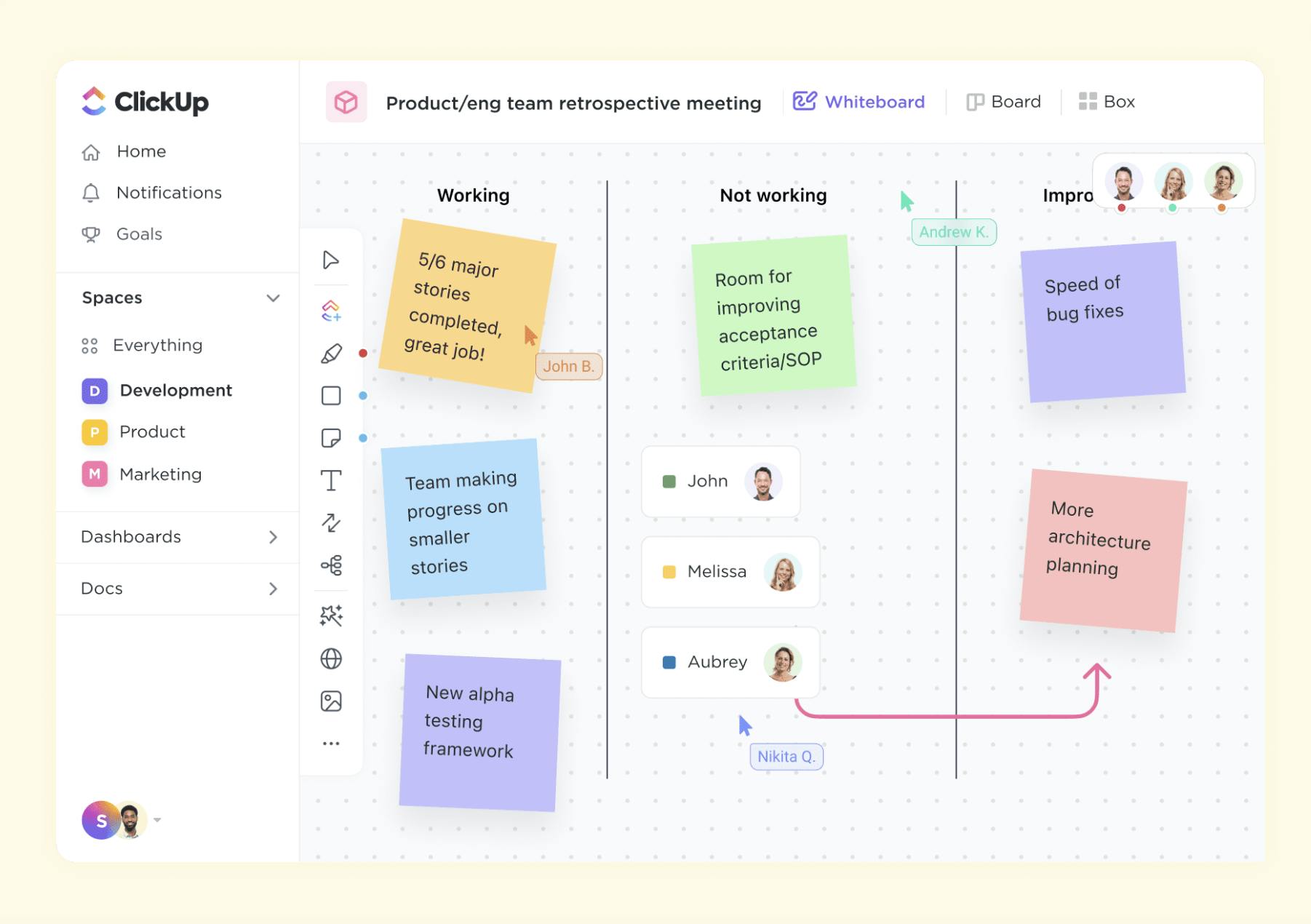
Source: ClickUp
Dashboards
ClickUp Dashboards is a tool for creating and customizing visual displays of key performance metrics. Users can create and manage multiple dashboards with custom widgets and layouts. Users can choose from various pre-built options or create custom options using data from various sources, such as goals, tasks, time tracking, etc. The drag-and-drop interface allows users to arrange and resize widgets. Built-in filtering and grouping options help with viewing data in various formats.
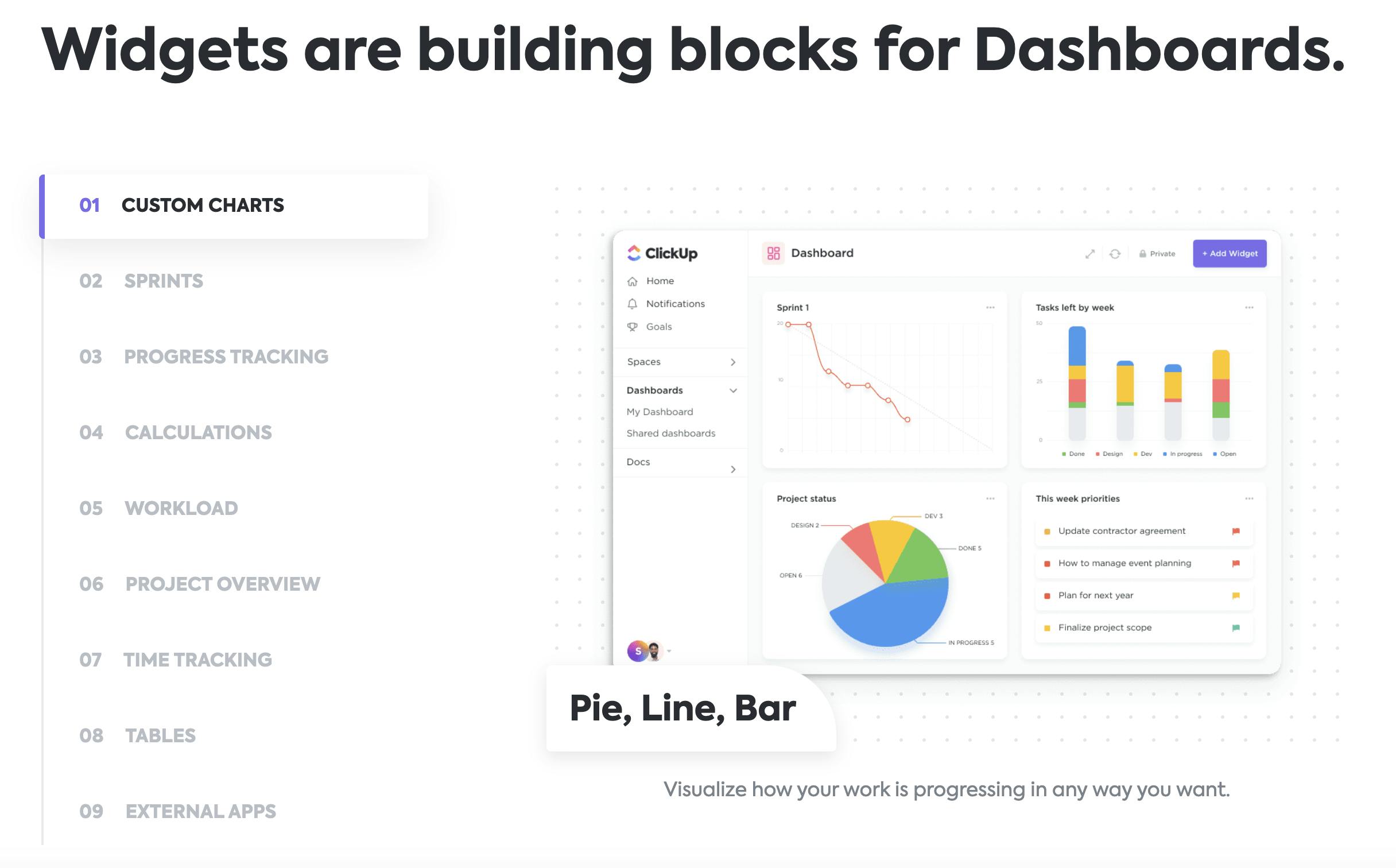
Source: ClickUp
Chat
ClickUp's Chat feature allows real-time communication and collaboration among team members. Users can create direct or group chats, share files and images, search past conversations, highlight important messages, and email directly within ClickUp. Users can also embed webpages, spreadsheets, videos, and more for easy access and include code blocks, bulleted lists, banners, and more to communicate work details more clearly.
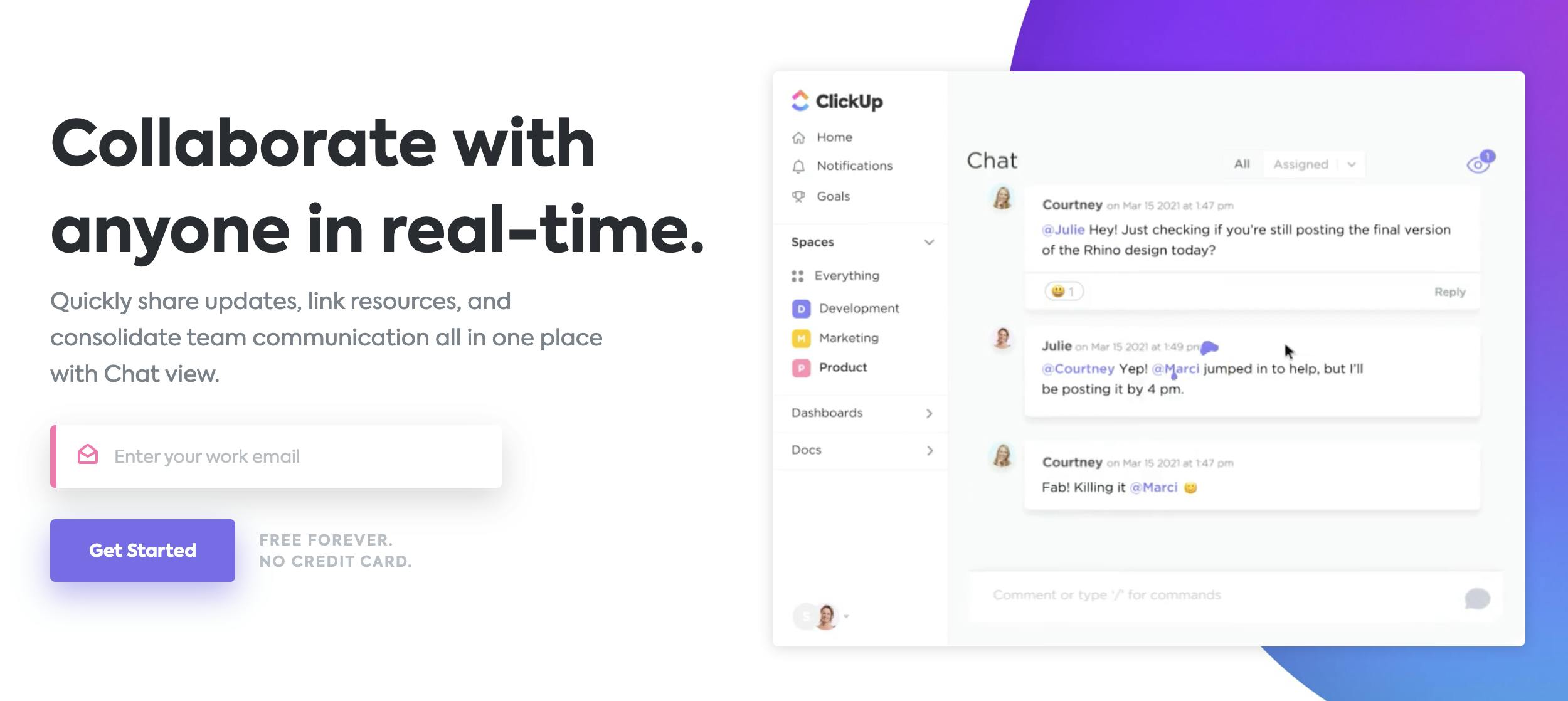
Source: ClickUp
Additional Features
ClickUp's integrations functionality offers a library of third-party services users can integrate with their accounts. This library includes many popular tools including Google Drive, Slack, GitHub, Zoom, Figma, and many more. Integrations allow users to streamline their workflow, improve the automation of repetitive tasks, and consolidate data and information in one place.
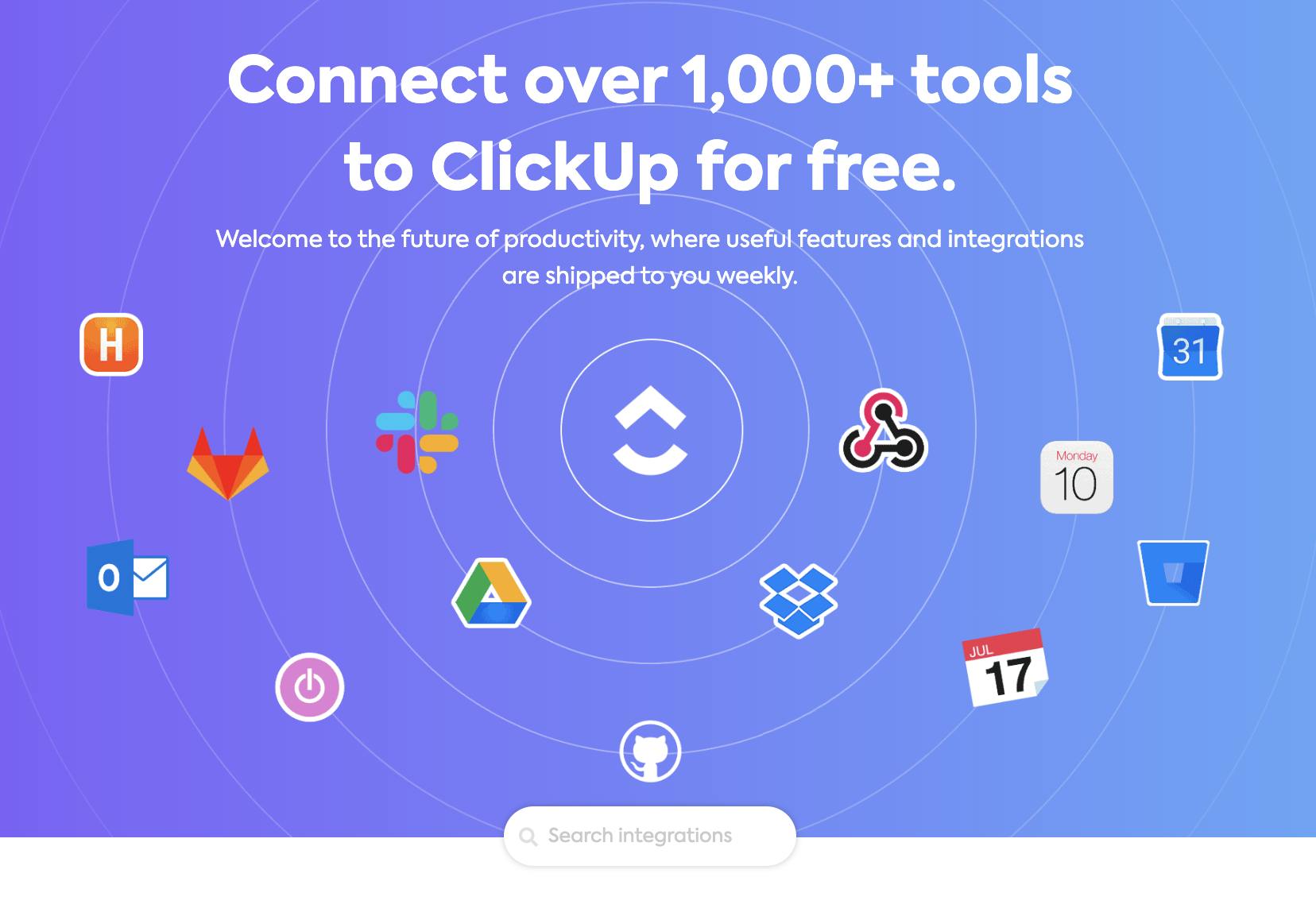
Source: ClickUp
ClickUp also offers tools to automate repetitive tasks and streamline workflows. Users can create custom automation trigger actions based on specific events or conditions. Additionally, users can integrate third-party apps and services to create more powerful and complex automation to help save time.
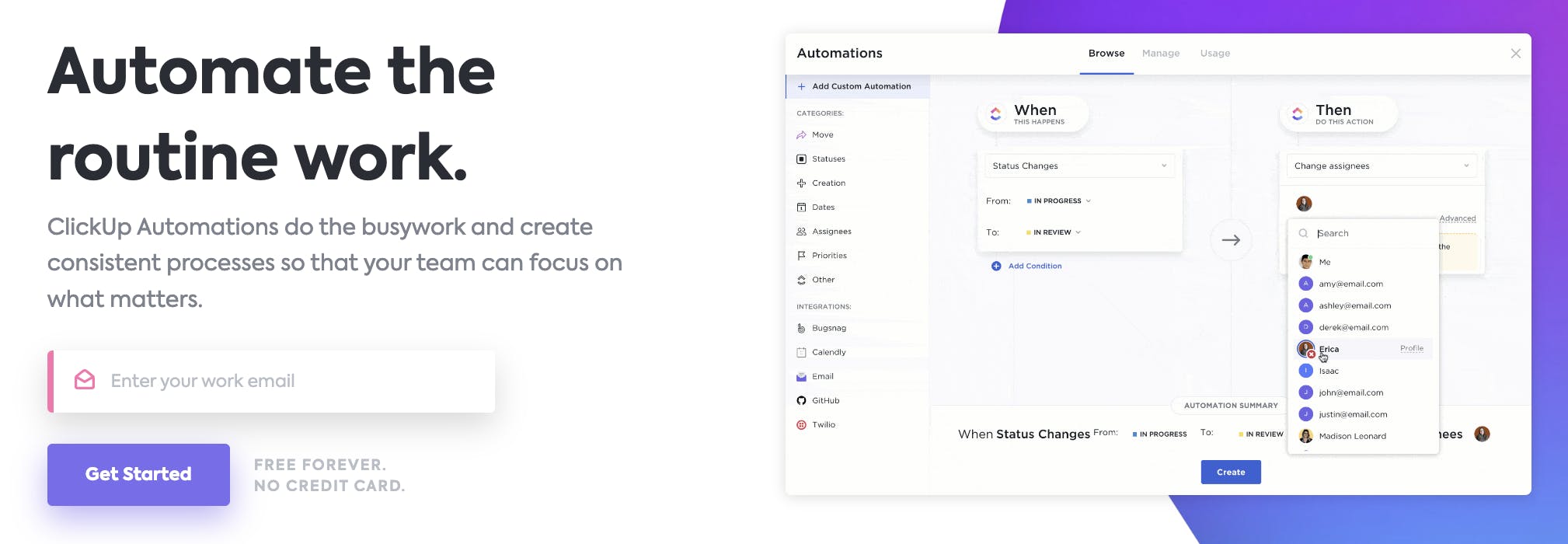
Source: ClickUp
In addition to being available on desktop, ClickUp is also offered as a mobile app for iOS and Android devices and an Apple Watch app. Furthermore, ClickUp has plans to release a version of its platform for the Meta Quest.
ClickUp University
ClickUp University is a learning platform to help users learn to use the ClickUp platform. The university offers courses, resources, and certifications.
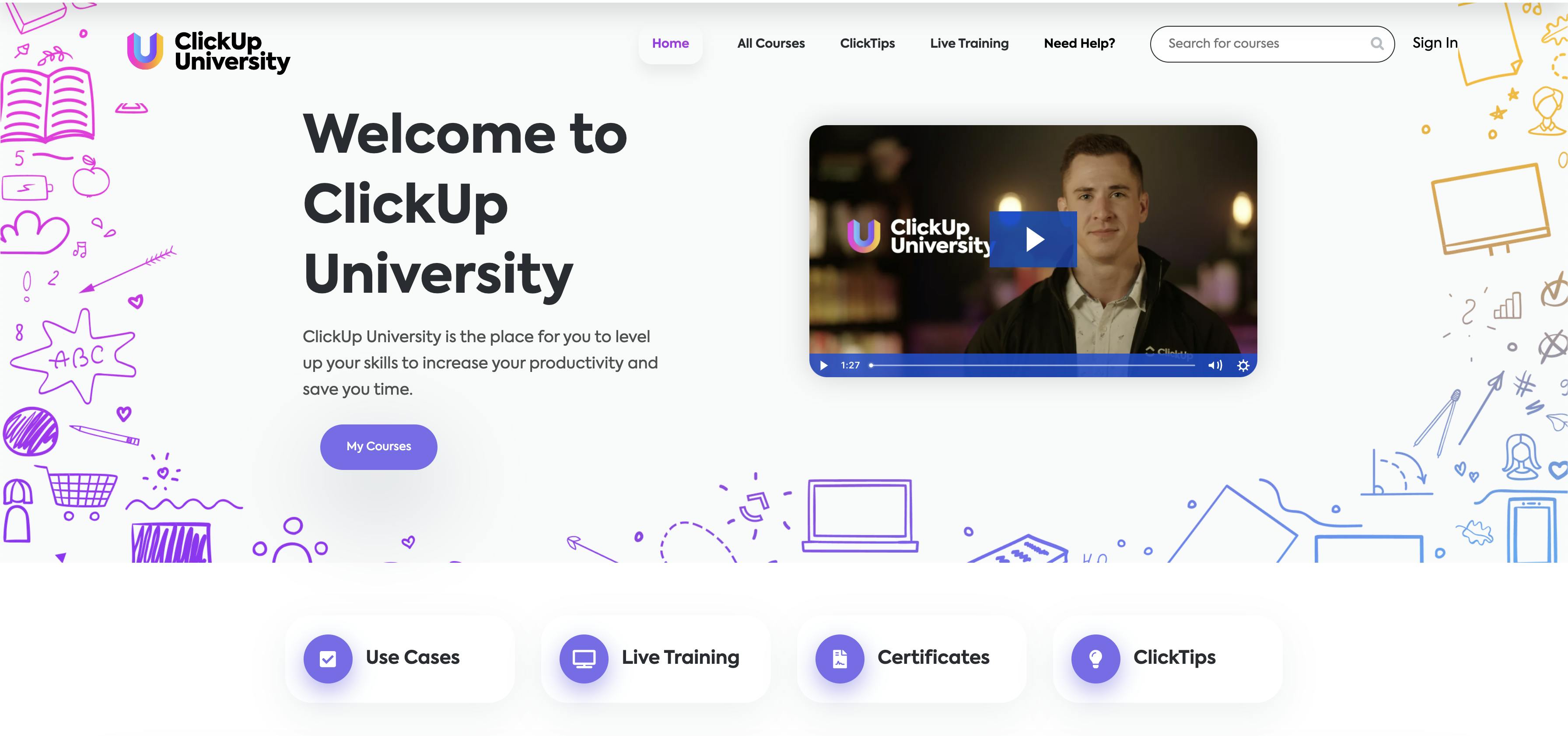
Source: ClickUp
ClickUp 3.0 and ClickUp AI
In February 2023, ClickUp announced ClickUp 3.0, the next version of the ClickUp platform that is more powerful and reliable for users. ClickUp 3.0 will also offer new features, including a universal search function, custom task types, a universal inbox, personalized home dashboards for users, and more. As of May 2023, there is a waitlist for ClickUp 3.0 and for ClickUp AI, the company’s set of generative AI tools.
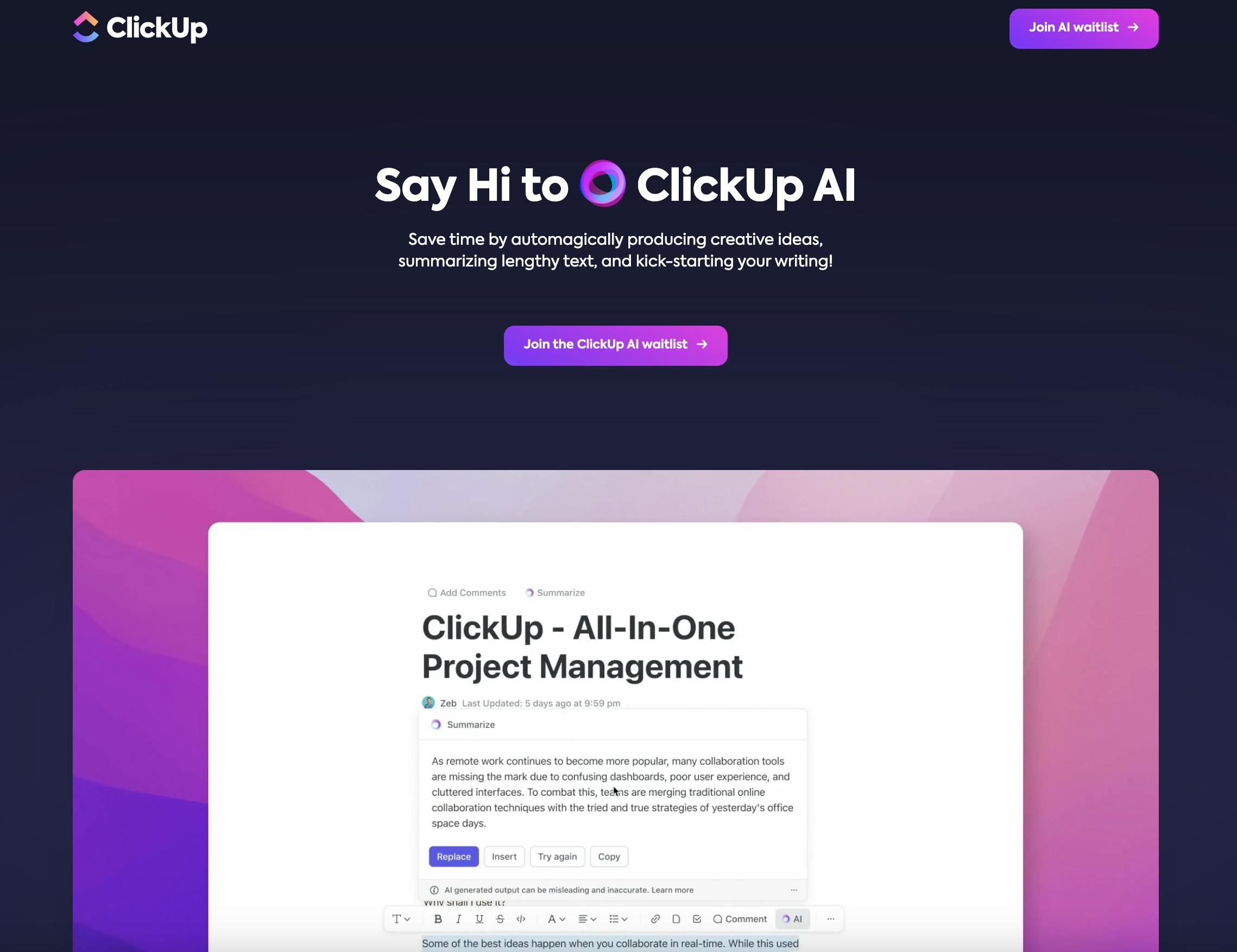
Source: ClickUp
Market
Customer
ClickUp aims to offer a productivity suite for users of all backgrounds. It has developed and portrayed its platform to be customizable and suitable for a wide range of industries and uses. ClickUp serves enterprise-level companies, startups, and nonprofits. ClickUp targets a variety of departments within organizations including software development, marketing, sales, design, human resources, operations, and more. It does so with custom landing pages, templates, and customer testimonials for each. Notable ClickUp customers as of May 2023 include McDonald's, Booking.com, Netflix, IBM, and Spotify.
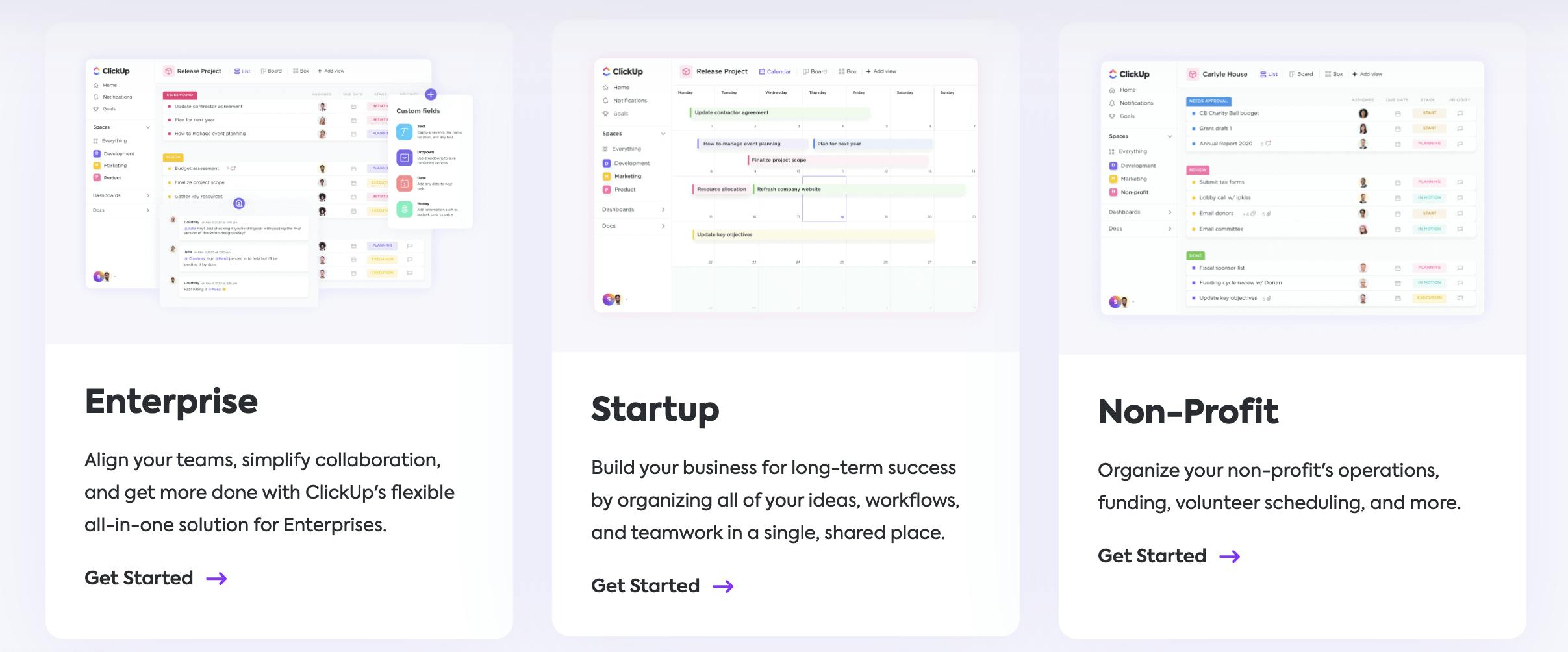
Source: ClickUp
Market Size
The market size for project management software has grown rapidly, driven by increasing demand for collaboration tools and remote work solutions. The global project management software market is expected to reach $149.7 billion by 2030, representing a CAGR of 13.8%.
Competition
monday.com: monday.com is a project management platform founded in 2012 that offers a visual and customizable approach to project management. The platform offers a range of features, such as boards, timelines, and calendars to help teams manage projects, tasks, and workflows. When it was a private company, monday.com raised a total of $384.1 million in funding. In June 2021, monday.com went public. Like ClickUp, monday.com offers a range of productivity tools and options. However, monday.com has also shifted focus toward higher-end, segment-specific enterprise tools, including a sales CRM and developer and marketing-specific productivity platforms. In 2022, its revenue was $519 million, an increase of 68% year-over-year. The number of paid customers was over 186K, up 23% year-over-year.
Asana: Asana is a project management platform founded in 2008 that helps teams manage tasks, projects, and workflows. Asana offers a range of features, such as boards, timelines, and calendars, similar to ClickUp. However, Asana focuses more specifically on catering to enable the needs of functional teams across marketing, product, IT, operations, and sales teams. As a private company, Asana raised $453.2 million in total funding. In September 2020, Asana went public. ClickUp claims to offer many free features that Asana offers as paid features. In 2022, its revenue was $547.2 million, an increase of 45% year over year.
Atlassian: Jira is a project management tool owned by publicly-traded Atlassian that is widely used by software development teams. Created in 2002, Jira offers a range of features for issue tracking, project management, and agile development. While Jira has a narrower focus on software development than ClickUp, it offers a range of advanced features specifically designed for agile development teams, such as scrum boards. However, Jira's interface can be more complex and difficult to navigate than ClickUp's. Trello, another Atlassian product, is a visual collaboration tool that uses boards, lists, and cards to help teams organize and prioritize tasks. Founded in 2011, Trello had raised $10.3 million in funding and was acquired by Atlassian in 2017 for $425 million. Trello's interface is similar to ClickUp's, focusing on visual organization and customization. However, Trello's feature set is more limited than ClickUp's, and ClickUp claims to offer many free features that Trello offers as paid features.
Wrike: Wrike is a project management platform founded in 2006 that offers a range of project planning, task management, and collaboration features. Wrike has raised a total of $26 million in funding. Wrike claims to offer multiple features ClickUp does not, though ClickUp claims to offer many free features that Wrike offers as paid features. Citrix bought Wrike in 2021 for $2.2 billion.
Notion: Notion is an all-in-one workspace tool founded in 2016 that offers a range of features for note-taking, project management, and collaboration. Notion has raised $343.2 million in funding and reached a $10 billion valuation as of July 2022. Notion's interface is customizable, with various templates and tools for organizing information. However, Notion's feature set is more limited than ClickUp's and lacks some of the more advanced automation and reporting features of ClickUp.
Other Competitors
ClickUp exists in an increasingly crowded and overlapping field of productivity platforms across various sizes and stages. Today, ClickUp’s competitors also include companies like Basecamp, Microsoft, Google, and others.
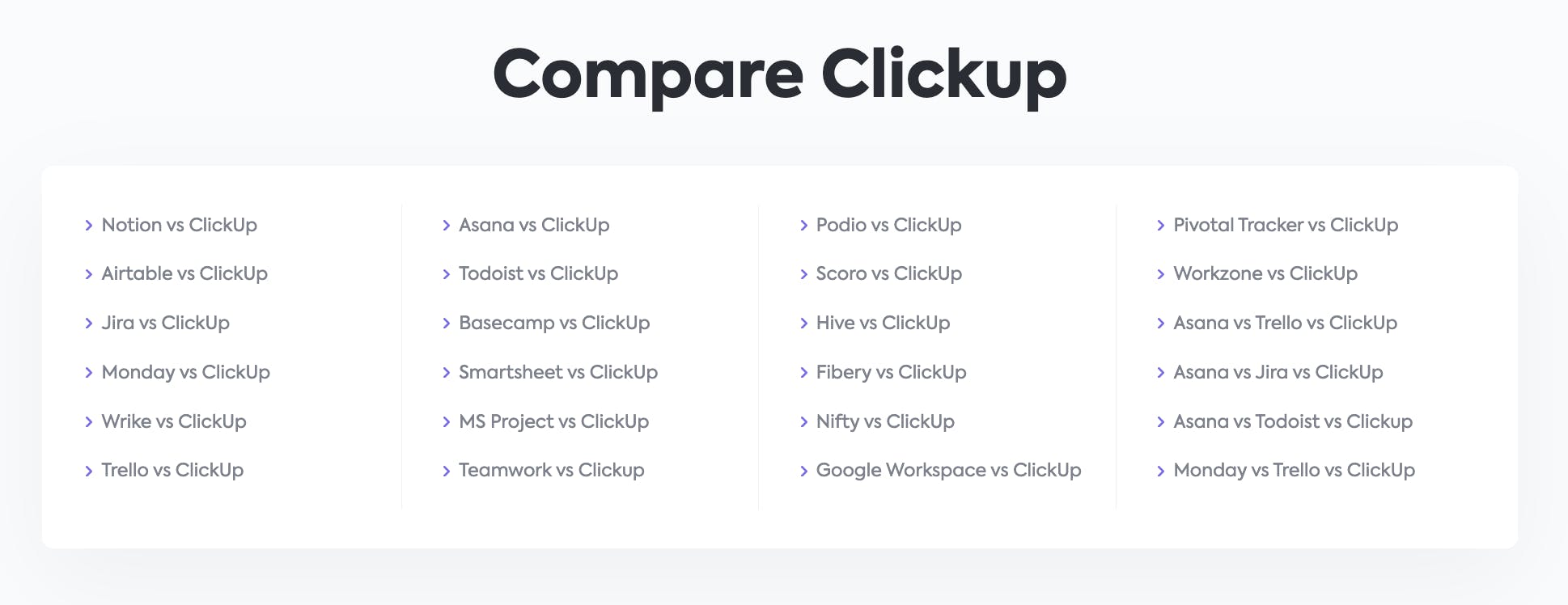
Source: ClickUp
Business Model
ClickUp operates on a subscription-based model, with various pricing tiers and plans designed to meet the needs of different users and organizations. The company offers a free plan with basic features and four paid plans with additional functionality and advanced features, ranging from $5 per member per month for the cheapest plan to $19 per member per month for the most expensive, with custom pricing for enterprise customers.
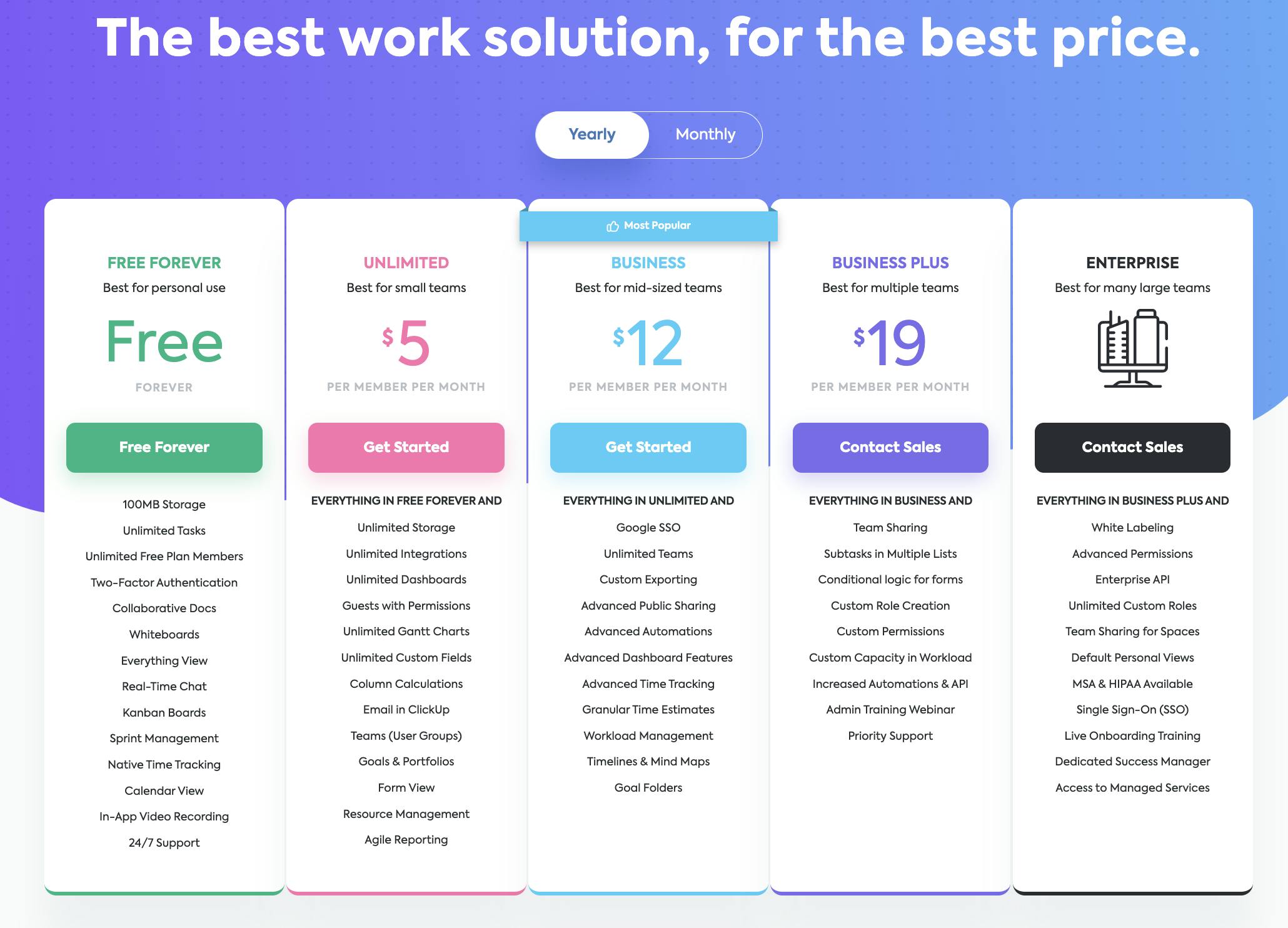
Source: ClickUp
Additionally, ClickUp offers affiliate and partner programs that allow businesses and individuals to earn revenue by promoting and consulting ClickUp and its users.
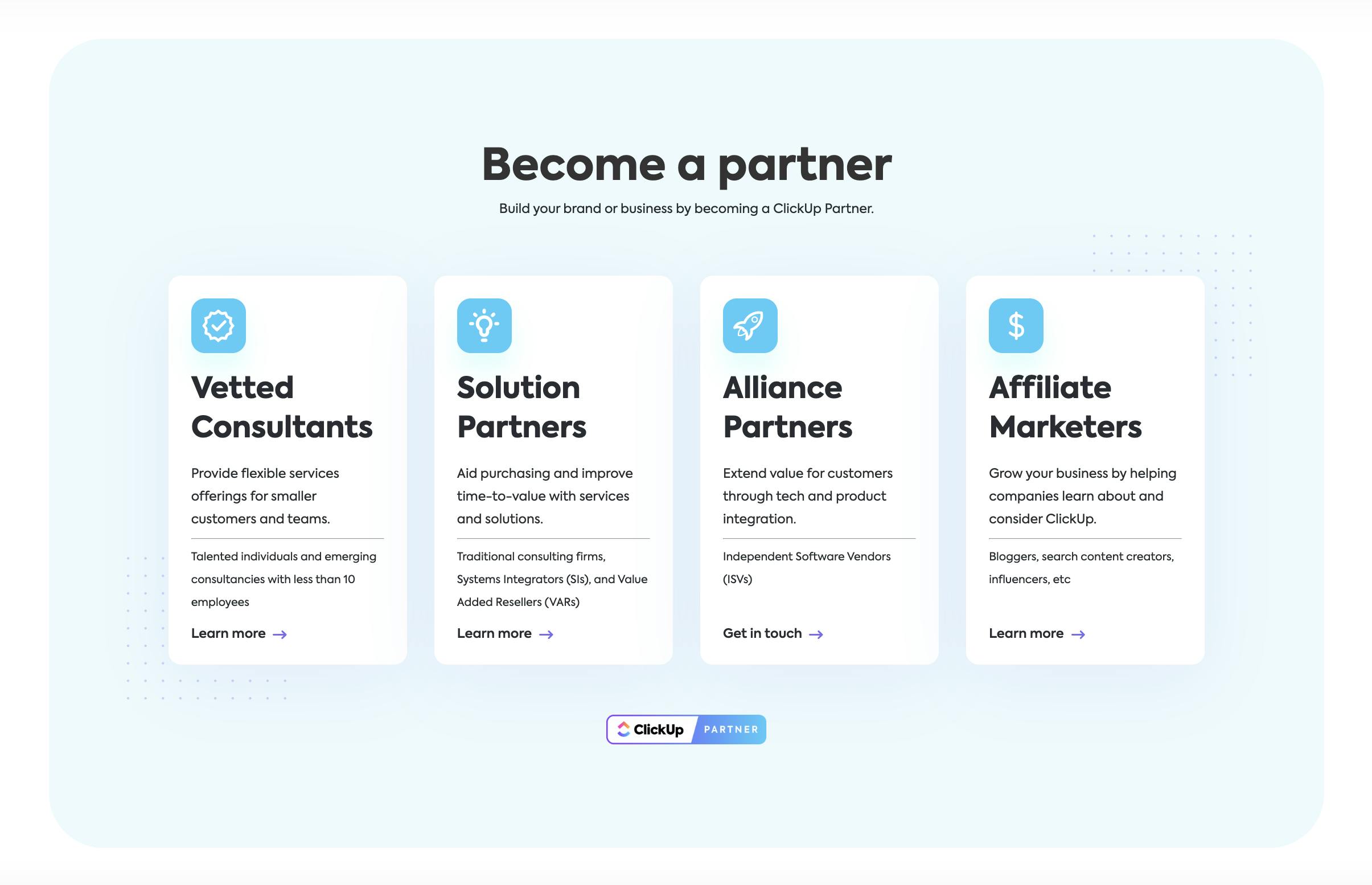
Source: ClickUp
Traction
In June 2020, ClickUp said more than 100K teams were on its platform. In December 2020, ClickUp said it experienced more than 900% revenue growth throughout that year, with 200K teams worldwide, including those at Google, Nike, Uber, Netflix, and Airbnb. At the time, ClickUp CEO Zeb Evans said the company had accomplished 60% of its vision.
In April 2021, ClickUp announced a partnership with the San Diego Padres to help improve the team’s IT operations. In December 2021, ClickUp announced its European HQ would open in Dublin, creating 200 jobs over two years and helping serve ClickUp’s 275K European teams using ClickUp at the time.
In February 2022, ClickUp announced the opening of a new Salt Lake City office with plans to add 250+ employees. The company also aired its first Super Bowl ad that month. In March 2022, ClickUp announced key executive hires across EMEA. At the time, the company also said European demand for ClickUp had risen, with more than 300K teams using the platform in the region.
In April 2022, ClickUp acquired the unified search and command bar platform Slapdash. In October 2022, ClickUp announced it had more than 100K paying customers. Throughout 2022, ClickUp users created nearly 28 million new ClickUp Docs, more than 1 million Whiteboards, and 654 million ClickUp tasks. In late 2022, ClickUp CEO Zeb Evans said the company’s revenue hit $85 million in 2021 and was on track to reach $200 million in 2022.
In February 2023, the company said its platform was being used by more than 8 million users across 1.6 million teams. In March 2023, ClickUp officially opened its Dublin office and said 575K teams in the EMEA region used ClickUp.
Valuation
ClickUp has raised $537.5 million in funding as of May 2023. ClickUp’s $400 million Series C announced in October 2021 gave the company a $4 billion valuation.
ClickUp’s publicly-traded rivals, which include Monday.com, Asana, and Trello owner Atlassian, are trading between 5.9x and 11.8x sales and have seen their valuations sink substantially in the aftermath of a COVID-19 pandemic era boom.
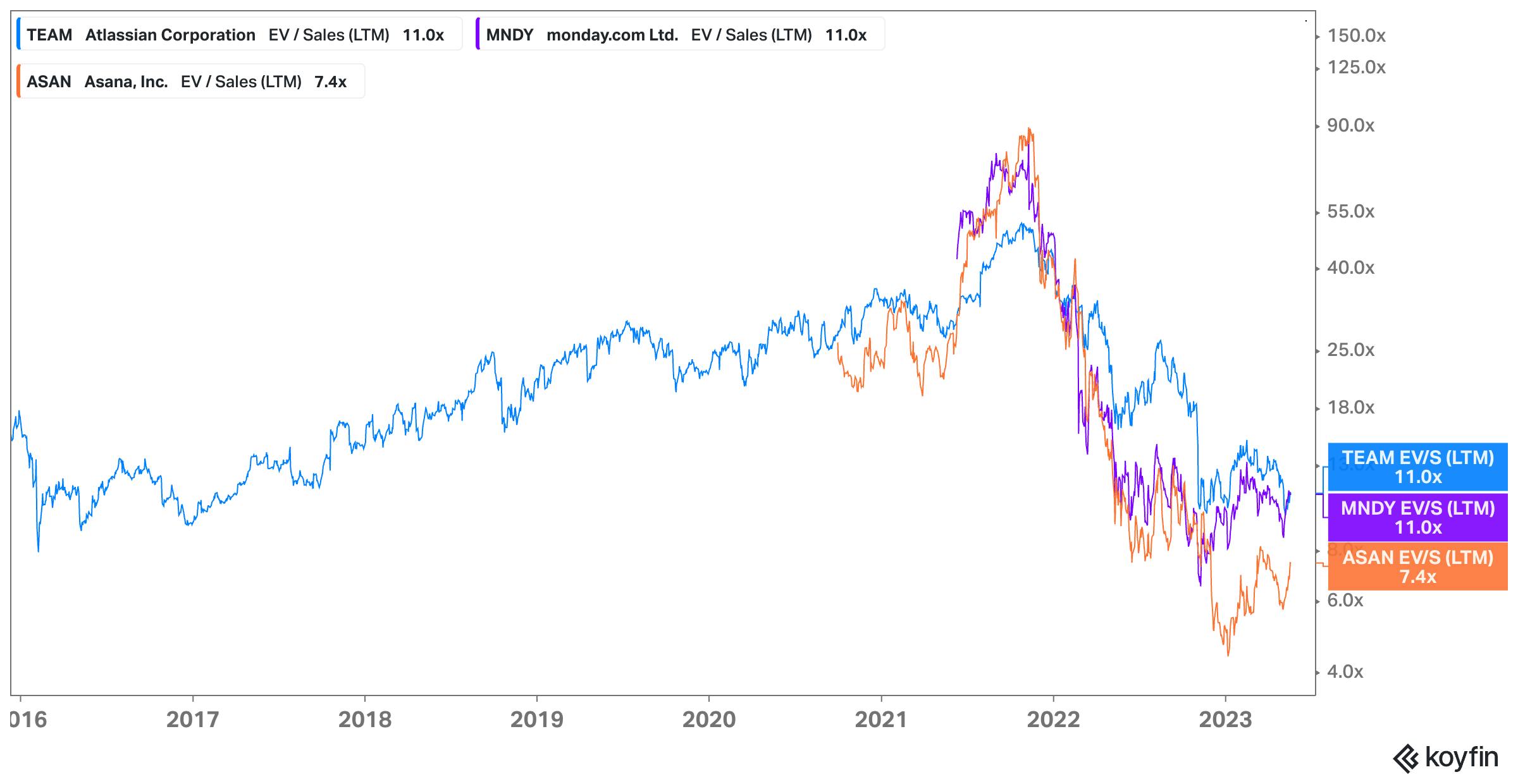
Source: Koyfin
Key Opportunities
Market Growth
The project management software market is growing rapidly, driven by the increasing demand for remote work and digital collaboration tools. ClickUp is well-positioned to capitalize on this trend given its robust feature set and user-friendly interface. The company can expand its market share further by targeting specific industries such as healthcare, finance, and education, and offering vertical-specific solutions.
Increasing “Toggle Tax”
As the number of apps companies use rises, individuals and teams will likely become increasingly frustrated by the “toggle tax,” spending significant time managing and collaborating across these platforms. This will increase the need for a solution that effectively addresses a growing pain point. By offering a bundle of features and updates that meet its customers' needs, ClickUp can position itself well to serve the crowded market for productivity software.
International Expansion
By offering productivity tooling that is intended to have universal appeal, ClickUp has the potential to expand its business globally by targeting new market geographies and increasing its presence in existing ones. The company could tap into emerging markets such as Asia, Africa, and South America, where digital solutions are accelerating. These expansions could help ClickUp diversify its revenue streams and increase its market share globally.
Key Risks
Fierce Competition
ClickUp operates in a highly competitive market with established players such as Asana, monday.com, and others. New entrants emerge frequently, and incumbents like Microsoft are increasingly working to innovate their own suite of productivity tools. This competition could lead to reduced market share growth for ClickUp, increased pricing pressure, or losing key customers.
Jack of All Trades, Master of None
ClickUp offers a continuously expanding set of features across its platform. An issue that may arise in striving to offer such a wide array of possible feature is that the company may begin to lose focus and the product might not be the highest quality option on the market for any particular use case. This issue is already apparent in some ways; as one industry consultant explained in an interview, while ClickUp checks many boxes and releases features quickly, its platform struggles from a lack of depth. This may eventually harm its ability to appeal to new customers.
Summary
Founded in 2017, ClickUp aims to save workers time and stress by offering a user-friendly software suite that provides a comprehensive solution for teams to collaborate, manage tasks, and track progress. The company has experienced rapid growth and raised over $537 million in funding. ClickUp is positioned to take advantage of significant opportunities for growth but also faces the risk of increased competition. To mitigate these risks, ClickUp can remain agile in its approach to rapid product development. Overall, ClickUp's success may depend on its ability to adapt to changing market conditions and customer needs while focusing on innovation, quality, and customer satisfaction.
